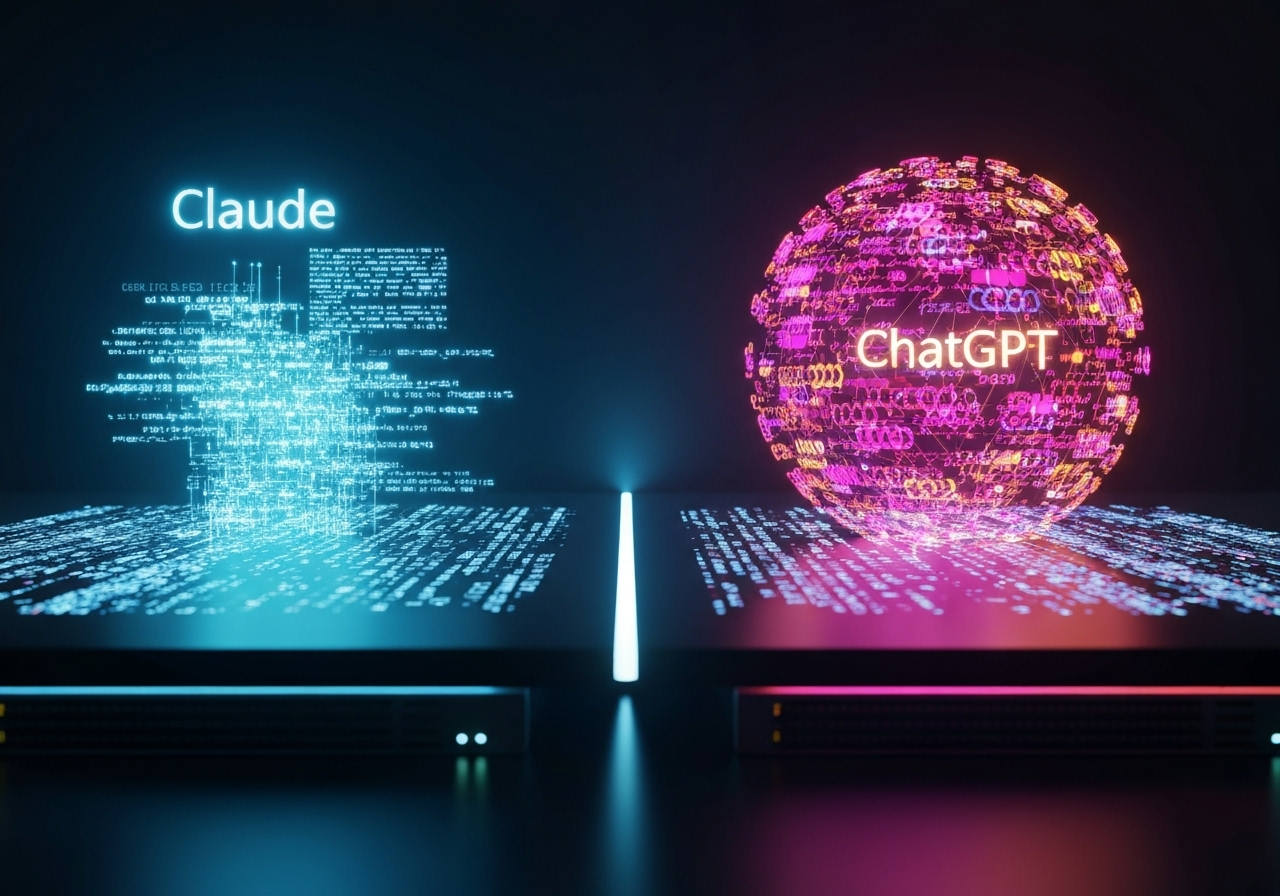Claude vs. ChatGPT: A Strategic Showdown for Enterprise AI Workflows
In 2025, the debate over which large language model (LLM) reigns supreme has moved beyond simple novelty and into the realm of mission-critical enterprise deployment. For businesses in Charlotte, NC, and across the globe, the choice between Anthropic’s Claude and OpenAI’s ChatGPT is a strategic one, often determining the efficiency, stability, and future scalability of custom AI-driven operations. This decision is no longer about raw performance on standardized tests; it is about which platform provides the most robust environment for complex, stateful workflows, particularly in agentic coding and autonomous data management. Understanding the core differences between the latest models is essential for maximizing ROI on your AI investments.
The central question facing technical leaders today is how to leverage these models for strategic business outcomes. Should you opt for the familiar and broadly integrated ecosystem of ChatGPT, or the reasoning depth and massive context window of Claude vs. ChatGPT? Both offer powerful capabilities, yet their foundational architectures lead to distinct advantages in different operational areas.
The 2025 Parity Problem: Comparing Latest Models, Context Windows, and API Cost
The “parity problem” refers to the perceived closeness in core intelligence between the top-tier models, such as GPT-5 and Claude Opus 4.1 or Sonnet 4.5. While benchmarks show a marginal performance edge often shifting between the two with every release, the true differentiator for enterprise users lies in three practical factors: context window, consistency, and cost structure.
Context Window: The New King of Reasoning
For complex tasks like large-scale code refactoring, deep debugging, or comprehensive document analysis, the size and consistency of the context window are paramount. The ability to hold an entire codebase or an extensive data pipeline description in memory drastically reduces drift and errors.
- Claude: Models like Opus 4.1 are known for offering a robust, consistent context window (up to 200K tokens) across various usage tiers. This makes Claude a definitive choice for tasks that require long-form reasoning and maintaining state over extended conversations or massive file uploads.
- ChatGPT: While base plans may offer smaller windows (e.g., 32K tokens for standard tiers), the API for GPT-4 Turbo can now support up to 1 million tokens for select enterprise use cases. However, this high capacity can be limited by plan level and is not always consistent across the standard chat interface.
Cost and Efficiency Trade-offs
The pricing models reflect their architectural strengths. Claude typically uses a token-based pricing that, while initially appearing higher, can be more economical for workflows involving very long documents or detailed, plan-first agentic steps where the consistency of the output minimizes expensive re-runs. ChatGPT often emphasizes high-frequency usage and a broader ecosystem, which can make it faster and cheaper for small, rapid-fire tasks and API integration.
For a detailed breakdown of how each model performs on specific coding tasks, including context handling and execution methods, engineering teams can consult specific 2025 LLM benchmarks that focus on development environments.
Agentic Coding and Autonomous Systems: Claude’s Artifacts vs. ChatGPT’s Custom Operators
Agentic coding—the ability of an AI to plan, execute, debug, and iterate on code autonomously—is where the platforms diverge most significantly in their user experience and functional capabilities. An autonomous AI agent, a core offering in the suite of digital services provided by Idea Forge Studios, relies entirely on the underlying LLM’s capacity for structured, multi-step operations.
The Agentic Workflows Comparison
| Feature | Claude (Artifacts & Projects) | ChatGPT (Code Interpreter & Custom GPTs) |
|---|---|---|
| Code Execution | Relies on external agents (Claude Code) or file manipulation tools; emphasizes planning over immediate execution. | Full, GPU-backed execution layer via Code Interpreter (Python sandbox) for in-chat coding loops. |
| User Interface (UI) Development | Artifacts provide live, persistent previews (HTML/Tailwind) and a cleaner separation of output for design-level polish. | Tools and Canvas provide visualization, but the flow for complex UI prototyping can be less structured than Artifacts. |
| Large Refactoring / Debugging | Superior. Extended context and Projects feature help maintain consistency across a large, stateful codebase. | Good for smaller fixes and API integration, but can suffer context drift on multi-file or deep debugging tasks. |
| Ecosystem | Focused on depth, persistent context, and collaboration tools. | Broadest ecosystem of plugins and custom GPTs for quick integration and varied use cases. |
For businesses focused on custom application development or complex systems integration, Claude’s method—which favors explicit planning before coding and guarded edits—translates into safer, more reliable automation. This plan-first, test-first approach is ideal for managing the risks inherent in large-scale refactors or high-stakes system changes, offering superior code quality on intricate tasks.
Strategic Data Handling: Leveraging AI for Database Cleanup and Custom CRM Development
Beyond coding, AI models are now essential for managing and transforming vast amounts of business data. This includes database cleanup, migration prep, and the development of custom systems like ERP or CRM solutions. In this domain, the difference between Claude vs. ChatGPT often comes down to their proficiency with structured data and their ability to handle the sheer volume of information.
When dealing with internal business data, such as inventory logs, customer records, or financial data, two factors are critical:
- Reasoning over Large Datasets: Claude’s consistently large context window makes it the preferred tool for uploading and reasoning across massive CSV files, database schema dumps, or long regulatory documents. It excels at finding subtle errors or patterns buried deep within the data.
- Integration into Custom Solutions: Many businesses in the Raleigh, NC area require custom e-commerce or CRM solutions tailored to niche industry needs. When building or maintaining these platforms, the LLM must be tightly integrated with the backend technology (like Python/FastAPI) to automate data validation, migration scripts, and real-time processing. This integration often requires precise, structured output that minimizes hallucination—a strong point for both top models, but Claude often demonstrates a higher level of long-term consistency in these tasks.
For businesses seeking robust, scalable e-commerce solutions in Charlotte, NC, leveraging AI for initial data structuring and continuous quality checks dramatically reduces the development cycle and post-launch maintenance burden.
The Integration Imperative: Orchestrating AI Automation with n8n Workflows
A sophisticated AI strategy demands integration. Neither LLM can operate in a vacuum; they must be orchestrated with other business tools and services. This is the realm of workflow automation platforms like n8n, which act as the central nervous system for AI agents, connecting them to databases, APIs, and cloud services.
Idea Forge Studios focuses on strategic use cases for integrating LLMs into automated workflows:
- Conditional Routing: Using the LLM to analyze incoming data (e.g., a customer service ticket) and decide which path the n8n workflow should take, automatically triaging requests.
- Data Normalization: Feeding messy, unstructured input (e.g., form data, email bodies) into the LLM and receiving clean, standardized JSON output, which is then used by the next step in the automation.
- Agentic Tool-Calling: Both Claude and ChatGPT excel at tool-calling, but their approach differs. ChatGPT’s broader ecosystem of custom GPTs makes quick, functional integrations easier, while Claude’s reasoning-first structure is better for multi-step, complex tool usage where the agent must maintain a history of its actions.
When selecting a platform, technical professionals must look beyond the models themselves and evaluate their native support for modern workflow tools. The ability to integrate seamlessly is ultimately more valuable than a slight edge in a single-turn benchmark.
Nuance and Tone: Choosing the Right LLM for High-Stakes Business Communication and Content
While often overshadowed by coding metrics, the models’ ability to handle nuanced language is critical for marketing and communication professionals. For SMBs and enterprises looking to enhance their online presence, the LLM chosen directly impacts the quality and tone of their generated content, from social media marketing copy to extensive white papers.
Claude, built with a strong emphasis on Constitutional AI and harmlessness, often exhibits a more reflective and ethically aligned tone. This is particularly valuable for high-stakes business communication:
“When generating content that requires a high degree of empathy, reflection, or adherence to strict ethical guidelines—such as internal corporate communications or complex legal summaries—Claude often demonstrates a superior ability to grasp and replicate subtle tonal requirements without unnecessary ‘fluff’ or oversimplification.”
Conversely, ChatGPT is often faster and more direct, making it excellent for high-volume, pragmatic content like product descriptions, email subject lines, and boilerplate API documentation. Choosing the right LLM should be based on the content’s purpose:
| Content Type | Ideal LLM | Reasoning |
|---|---|---|
| Complex Strategy Documents | Claude | Superior long-context memory and reasoning for synthesizing multiple internal documents. |
| Quick Ad Copy & Scripts | ChatGPT | Speed, brevity, and familiarity with popular marketing trends. |
| Internal Technical Documentation | Claude | Maintains accuracy and consistent architectural understanding over long context sessions. |
| Blog Posts & Articles | Both | Depends on the desired tone: Claude for deep authority, ChatGPT for speed and integration. |
The Final Decision Framework: Mapping AI Capabilities to Your Business Goals
The strategic choice between Claude vs. ChatGPT should ultimately align with your organization’s core business goals and the specific pricing and implementation structures you can support. Rather than seeking a single “best” LLM, modern businesses should focus on developing a hybrid strategy that leverages the unique strengths of each platform.
A Goal-Oriented LLM Selection Guide
For executive teams and technical architects in Asheville, NC, or Philadelphia, PA, here is a framework for deciding the primary LLM platform based on the most pressing business need:
If your primary goal is:
1. Large-Scale Code Management and Audits:
Select: Claude
Reason: Its extended context window and Artifacts for visual prototyping are indispensable for maintaining consistency and state across vast code repositories and deep debugging sessions. It forces a disciplined, plan-first agentic workflow.
2. Fast, High-Volume Automation & Prototyping:
Select: ChatGPT
Reason: Its speed, robust Code Interpreter execution environment, and expansive ecosystem of custom GPTs and third-party plugins make it the workhorse for rapid development, quick scripts, and broad API integrations.
3. Advanced Data Extraction and Transformation:
Select: Claude
Reason: For tasks involving processing and normalizing multi-gigabyte documents or complex, unstructured data, Claude’s superior long-context memory significantly reduces the number of tokens required to complete the task successfully and minimizes factual errors.
4. Building Custom AI Agents and Integrated Workflows (n8n, Python):
Select: Both (Hybrid Approach)
Reason: Use Claude for the complex, stateful reasoning layers (e.g., the planning, refactoring, and quality assurance steps) and use ChatGPT for the execution layers (e.g., quick boilerplate code generation, simple API calls, and high-speed data fetching). This allows you to combine Claude’s depth with ChatGPT’s speed, creating robust and efficient custom solutions.
Navigating the strategic choice between Claude and ChatGPT for enterprise AI requires expert implementation. If you’re ready to move beyond benchmarks and develop robust, integrated solutions for web development, e-commerce, or custom data workflows, let’s talk.
Take the next step: Request a consultation with Idea Forge Studios to begin building your custom AI-powered system or call us directly at (980) 322-4500.
You can also reach our team by email: info@ideaforgestudios.com








Get Social